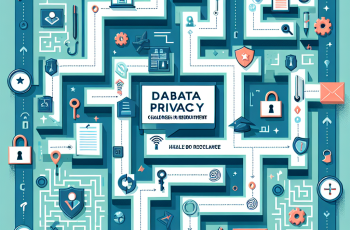Federated Learning: Revolutionizing AI Collaboration in the Recruitment Industry
Estimated reading time: 7 minutes
- Federated learning enables decentralized data privacy in recruitment.
- It enhances model training while respecting data privacy regulations.
- Organizations can collaborate on candidate profiling without compromising confidentiality.
- Implementing federated learning requires understanding its unique challenges and protocols.
Table of Contents
- What is Federated Learning?
- How Federated Learning Works
- Key Characteristics and Motivations
- Applications of Federated Learning in Recruitment
- Benefits of Federated Learning
- Challenges of Federated Learning
- Implementing Federated Learning in Your Recruitment Strategy
- Conclusion
- FAQ
What is Federated Learning?
Federated learning is a machine learning approach that allows multiple participants (clients) to collaboratively train a shared model while keeping their data decentralized and localized. Unlike traditional methods where data is aggregated in a central location, in federated learning, raw data never leaves the client device. Instead, only model updates or parameters are shared and subsequently aggregated (source: Wikipedia, IBM).
This innovative approach is especially relevant in sectors like recruitment, where personal data privacy is paramount. As the industry navigates increasing scrutiny around data handling and security regulations, federated learning presents a compliant alternative for organizations looking to leverage machine learning effectively.
How Federated Learning Works
Federated learning follows a systematic process relying on several crucial stages (source: IBM, DataCamp):
1. Initialization
A central server develops or initializes a global machine learning model and shares it with selected client devices or servers, which receive training instructions alongside the model.
2. Local Training
Each client independently trains the received model using its local data. This localized training involves executing standard model training processes, such as forward passes and parameter updates, but without exposing raw data.
3. Aggregation of Updates
After training, clients send only the model updates (not the data) back to the central server, where these updates are aggregated (usually through averaging the model weights) to refine the global model.
4. Iteration
The updated global model is redistributed to clients, and the process repeats to continuously refine the model’s performance.
This cyclical process demonstrates the collaborative power of federated learning, enabling organizations to improve their models without relinquishing control over sensitive data.
Key Characteristics and Motivations
Federated learning introduces several distinctive characteristics that make it ideal for deployment in recruitment and other sensitive industries:
- Data Privacy: By ensuring raw data remains on client devices, federated learning significantly reduces privacy risks and addresses legal concerns regarding data access and processing (source: IBM).
- Heterogeneous Data: Recruitment data can come in diverse forms and distributions. Federated learning accommodates this variability, allowing organizations to work with different data sources effectively (source: Wikipedia).
- Decentralization: Learning occurs on individual devices, further safeguarding sensitive data from breaches while enabling collaboration across organizations (source: IBM).
Applications of Federated Learning in Recruitment
As the recruitment sector advances, federated learning’s applications grow, especially in areas where data privacy and compliance are critical. Here are several ways federated learning can be leveraged within the recruitment industry:
1. Collaborative Candidate Profiling
Organizations can collaboratively improve candidate profiling models by sharing insights derived from different datasets while ensuring that individual applicant data remains confidential. This cooperation can enhance the quality of hiring algorithms, reducing biases and improving placement success rates.
2. Training Predictive Analytics
Recruitment agencies may employ federated learning to develop predictive analytics for hiring trends, employee retention, and candidate responsiveness without needing to centralize sensitive applicant data. By pooling knowledge from various agencies while maintaining data privacy, predictive models can deliver enriched insights for better decision-making.
3. Enhancing NLP Models for Resume Screening
Natural Language Processing (NLP) models can benefit from federated learning by training on multiple local datasets to identify relevant skills and keywords from resumes more accurately. This method maintains privacy while improving the relevance and efficiency of candidates being shortlisted.
4. Improving Engagement Algorithms
Companies can build and refine engagement models that predict applicant behavior and sentiments. By utilizing decentralized training, they can access a broader variety of data, helping HR professionals tailor their communications and engagement strategies effectively.
Benefits of Federated Learning
The rise of federated learning brings several key benefits to the recruitment sector:
- Enhanced Privacy Protection: Safeguarding sensitive applicant information significantly reduces the risk of data breaches (source: IBM).
- Regulatory Compliance: As privacy laws, such as the GDPR, tighten, federated learning allows companies to stay compliant while engaging in collaborative efforts and innovations.
- Cost Efficiency: Reduced data transmission and storage needs can lead to lower operational costs and streamlined processes (source: Splunk).
Challenges of Federated Learning
Despite its advantages, adopting federated learning as a solution comes with challenges:
1. Communication Overhead
The process of exchanging frequent model updates can consume significant bandwidth, which may slow down overall training cycles.
2. System Heterogeneity
Variations in computational power and network connectivity among clients can create inconsistencies affecting training speed and reliability (source: Wikipedia).
3. Data Quality and Bias
Federated learning relies on the quality and representativeness of local data—poor data quality or biased datasets from individual clients can compromise the effectiveness of the overall model (source: Wikipedia).
4. Security Risks
Even though raw data is not shared, the exchange of model updates remains susceptible to privacy attacks, necessitating robust security protocols to safeguard the model and sensitive information.
Implementing Federated Learning in Your Recruitment Strategy
For HR professionals and business leaders considering the adoption of federated learning, here are some practical takeaways:
- Invest in Education: Familiarize your team with the principles and applications of federated learning to understand how it can enhance your recruitment efforts.
- Assess Data Sources: Identify all potential data sources and categorize them based on their relevance, quality, and potential biases to ensure effective collaborative training.
- Evaluate Security Protocols: Focus on establishing strong security frameworks to protect model updates and ensure compliance with data privacy regulations.
- Pilot Programs: Start with small pilot programs that can demonstrate the efficacy of federated learning approaches within your organization before a full implementation.
- Collaborate with Tech Partners: Consider partnerships with AI consulting firms that specialize in federated learning and machine learning implementation. Their expertise can help you navigate challenges and effectively utilize this approach.
Conclusion
Federated learning represents a significant shift in how organizations can harness collaborative machine learning while respecting privacy concerns. As the recruitment industry increasingly prioritizes data sensitivity, this model not only enhances compliance but also offers new opportunities for innovation. By adopting federated learning principles, HR professionals can leverage distributed data to build better predictive models, enhance candidate engagement, and create more effective hiring strategies.
FAQ
What is federated learning? Federated learning is a machine learning method that allows multiple clients to collaboratively train a model while keeping their data decentralized.
How does federated learning protect data privacy? By ensuring raw data remains on client devices, federated learning mitigates risks associated with data breaches and regulatory non-compliance.
What are the main benefits of federated learning in recruitment? Benefits include enhanced privacy protection, regulatory compliance, and cost efficiency through reduced data handling.
What challenges must companies face when adopting federated learning? Challenges include communication overhead, system heterogeneity, data quality issues, and potential security risks associated with model updates.
How can organizations start implementing federated learning? Organizations can start by investing in education, assessing data sources, evaluating security protocols, piloting programs, and collaborating with tech partners.

